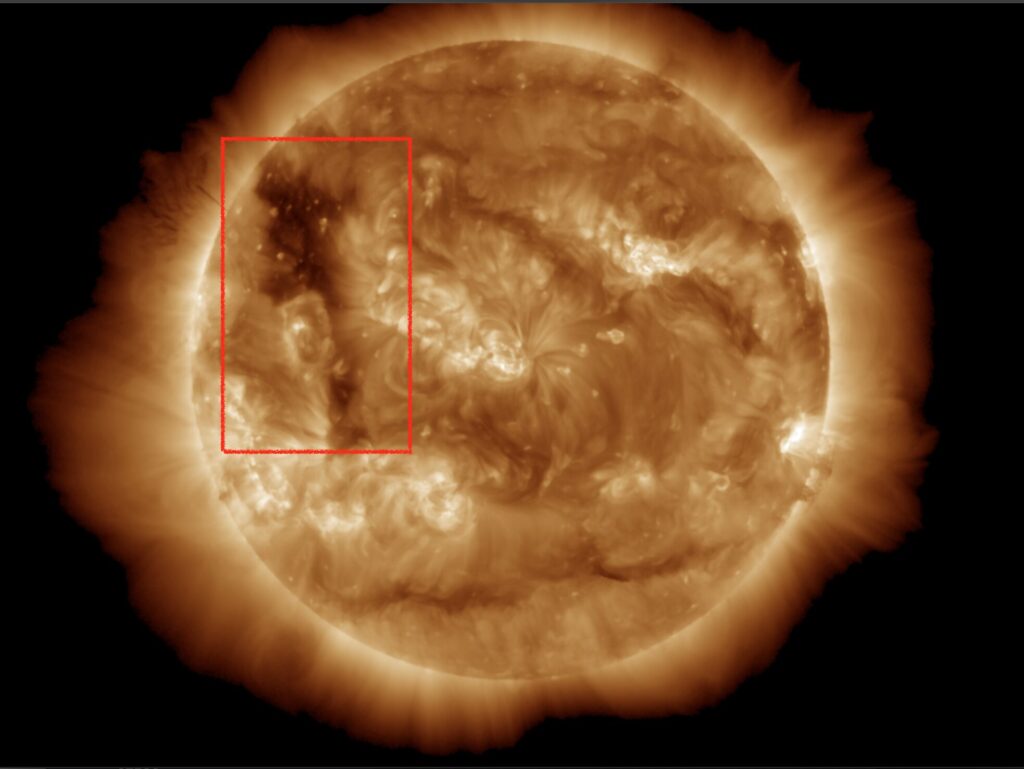This is what a solar synoptic map looks like. They are updated every three hours at SWPC, and give us all the information we need to know about Coronal Holes.
Here is one such coronal hole, which should be geo-effective until about the 20th or so. It’s a bit bigger than the last trip around- but just because it’s bigger doesn’t mean we will see more activity.

It’s kind of like a volcano. I guess. So you can have a big volcano. But that doesn’t mean you’re going to get an eruption. I mean- you are getting eruptions. You’re getting them all the time. The sun is just one big hot mess of gas just erupting all over the place all the time. But conditions have to line up. You have this coronal hole, you get a coronal mass ejection, and it has to align the right way when it gets here three or so days later with Earth’s poles. It’s a lot.
First off, coronal holes. Why are they black? Well, the plasma in that region is much less dense, and the region is cooler in temperature.
Coronal holes are also “unipolar,” which means only one pole- and your brain will fry if you try to imagine earth with only one pole. What would happen? Well, I think the whole place would just sort of topple over and get sucked out the other end, through the remaining pole, and off into space. Which is what happens with solar winds. A coronal hole being unipolar creates a passageway for massive amounts of solar gas to pass through. The gas becomes wind, as there is no opposing pole to keep in centered and in one place. This is how my brain works, my friends, because I know that if there were not two poles on this earth, I would be mush.
And, since there’s no opposing pole for all those charged particles to fetch up against, they stream out into space toward something- anything- that might attract them. Or not. They might dissipate off into the vast unknown. Or, they might be aligned with our earth’s poles, and make a beeline for the nearest magnetosphere they can find. In which case, we get our Aurora.
The funny thing about coronal holes is that there are more of them for some reason during solar minimum. Hence, you can get good light shows at minimum, not just maximum. They are more stable at the north and south poles of the sun, and can last a few 27 day rotations. So we do see them come back around again a few times generally, and they will be bigger, or smaller, and we will know something about how they behaved the last time they were with us.
The longer-lasting coronal holes are good sources for high speed solar winds, because things build up. What happens is that you get rotating regions of gas, due to the pressure differentials between the less dense, cooler area of the coronal hole and the hot, fast moving gas erupting out of the sun. A compression region forms, which you’ll see called a CIR, or Co-Rotating Interactive Region.
You’ll also see this acronym: CH HSS. This stands for Coronal Hole High Speed Stream. A CIR can look like it’s kind of pulling or leading out a CH HSS if you’re looking at the data.
A CIR can result in what SWPC calls “particle density enhancement” and “interplanetary magnetic field strength increases.” I’m honestly not sure how you can enhance the density of a particle. A particle is a particle. Once SWPC starts getting paid again, maybe someone can explain that to me. I believe there is a Dr. Seuss book in which a particle of dust somehow comes into play. If you think about it, you really can’t do much with a particle. I guess you can clump a bunch of them together, and maybe this is what SWPC means. I don’t know.
But, many of us are familiar with the concept of accelerators. You can have a particle accelerator. For example, if you decide to put your little sister in a barrel, and put the barrel on the end of a see saw, and then get your friend to jump on the other end of the see saw, thereby launching your little sister into the air, I suppose you have accelerated your little sister. You haven’t exactly done much with her particulate composition, unless of course it all ends very badly and everyone is now in the minivan headed to the emergency room for stitches. But it’s the same idea. Some force- the CIR- is acting upon the IMF to increase its speed. Which equates to strength. And we get the Coronal Hole High Speed Stream, or CH HSS.
For some reason, the coronal holes nearer the sun’s equator are more likely to give us this kind of activity. As mentioned earlier, things are more stable and less reactive closer to the sun’s poles.
SWPC forecasters do a chart of our sun’s sunspot regions every three hours, and watch activity very closely, due to the implications to the power grid and security risks that solar storms pose. We watch all this activity simply because we love the Aurora, which is something of a side product of why we have access to all this forecasting.
Here at MABW, we often reference the SWPC three day forecast, which draws from this forecasting data, but there is also a more detailed Forecast Discussion .
You can click on this link to get to the Solar Synoptic Map that is updated every three hours.
For SWPC’s run-down on Coronal Holes, which is referenced in this post, click here: https://www.swpc.noaa.gov/phenomena/coronal-holes

